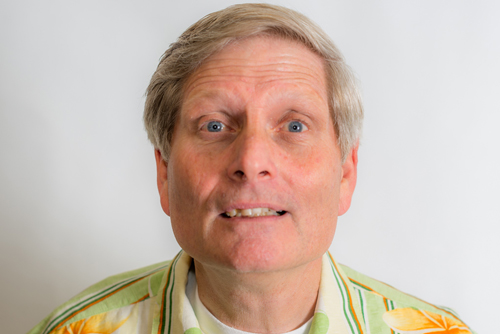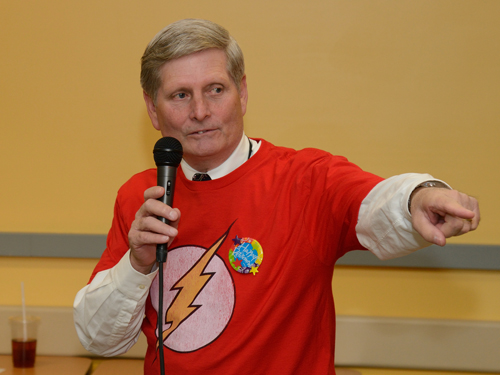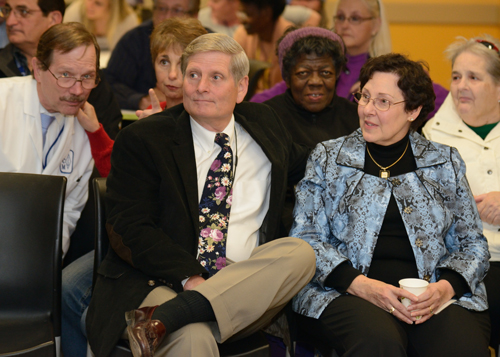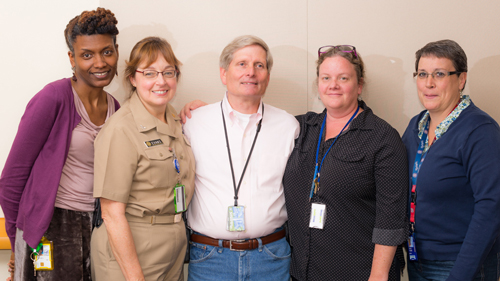Fred Manuel, NIH employee since 1976, recalls Clinical Center improvements over the years

Fred Manuel, facilities manager for the NIH Clinical Center, began his career at NIH in 1976 and came to the Clinical Center in 2001. On Nov. 15, his last day of work before retirement, he shared his memories of working at the Clinical Center with Janet Hulstrand, from the NIH Clinical Center's Office of Communications and Media Relations. Sitting in the atrium for the interview, Manuel was frequently interrupted by the waves and well-wishes of his colleagues and friends.
So this is your retirement day. You've been here how long?
I started here Dec. 5, 1976.
And what's your title?
I'm facilities manager for the Clinical Center.
And what was your first job here?
I started as a carpenter over in Building 13.
How did you find your way to a job here? How did that happen?
I was working on the outside, at the Goddard Space Center at the time, and I lost my job. I had a wife, a baby and four months unemployment, so I walked around to any government agency that would accept papers and dropped them off, and luckily ... Well, I started at the Smithsonian, at the Air and Space Museum first. I worked there for nine months when the museum first opened. Then, they offered me a job here, and it was a higher grade, so I came here. And it was closer to my house.

So tell me a little bit about the various roles you've played here ... it's always been at the CC, right?
Well, actually I spent 26 years in what used to be called DES and is now considered the Office of Research Facilities. I went from carpenter to planner/estimator. I was going to college, taking architecture part time, and then after that, I did CAD design for five years. After that, they switched me over to project management. And then, I got the chance to come over here to the Clinical Center, which I wanted to work at.
And when was that?
2001. January 2001.
But before that, the other work was at NIH, right?
Yes. I've spent most of my life here.
What are some of the most interesting changes you've seen in the time you've been here?
Well, I've actually seen them dig out the holes for the ACRF to be built. I did a lot of the punch-list items and helped when they got ready to move into the newer building, which is where the clinics are. And I watched them build the new ORs. When I came here, the original ORs were on the 10th floor in Building 10 and Radiology was on the 6th floor. There've been a lot of changes in how the building was. The old front of the building used to have two ponds on the side. And at that time, the Director of DES, he used to live in a house right across the street. Actually, his house, where it used to be on the reservation was probably right where we're sitting now. He was an avid fisherman, and he'd go out, and he'd come back, and he'd drop the fish in the pond, and every so often people would see him there fishing around the pond.
I also did the walkthroughs when they broke the ground for the CRC. We walked through all the stages of construction and sat through all the construction meetings. We helped with opening the building and checking to make sure everything was right, fulfilling the Joint Commission standards for them to open it up.
I'll bet there were a lot of challenges along the way...
Yes, there were, but it was a lot of fun; it was challenging, but every day you didn't know what you were going to do. We were making sure the other building was still running, looking after the hospital at the same time too.
Are there any events, or any particular periods of time that stand out in your mind as you look back?
I've had the pleasure to work with a lot of doctors that are top notch around this place. I grew up in this area, and when I was a kid, we had some friends that, when it first opened, they were patients here. As a kid, I always thought whoever came to NIH died. ... I was never aware of how much good comes out of this place. It's totally amazing, every day. I've met some amazing people. I worked with the Secret Service when Prince Charles came, and when George W. Bush came here.
Tell me more about that...
Well, our office would work with the Secret Service. They would look at the floor plans of the areas. Then they would visit the areas to decide how they would protect the VIPs. We also worked to help set up communications for the days of the events. We would walk through the areas with the NIH police department and fire department as needed. It was challenging, but it's really neat. Something most people never get a chance to do.

Absolutely! What has been your favorite thing about working here?
I like to know that I'm here helping the patients. If I ever see anybody that looks like they're puzzled, I'll help them out, because getting around this place is so overwhelming. So, I'll help them find how to get where they need to get and try to make them feel welcome and warm.
Everybody here is really nice. In the past couple years, my wife came down with cancer, and actually, this place found it. She was misdiagnosed a couple of times, and they just happened to have a protocol. So, it's even helped me personally.
And she's okay now?
Yes, she's doing good.
So, do you get to know the patients at all?
Not really. Some patients, you'll see them around here, they've been here an awful long time, and I say hi to them. There's a young lady, I don't know what her name is, but she's been here probably for the past year or so. She's wheelchair bound, so I make sure to go talk to her, see how she's doing. Put a smile on her face, make her feel good. She's not getting out of the building too much.
What was it like, from your perspective, from your work, when the Hatfield Center went up? What was your job in connection with that?
We would do the walkthrough and acceptance for the Clinical Center, of all the spaces. So we would go into the patient rooms and make sure all the rooms were what the Joint Commission required. And we'd go in and test all the electrical receptacles, and all that, and go around and make sure there was the right number of air flow changes, and go to meetings. Ray Bowen, he's getting ready to retire on January 3, he went up and did 5 NE special unit for NIAID. They've got all kinds of special air equipment for air changes and containment, and anybody who would get affected by Anthrax, or SARs, or tuberculosis, any of that stuff, they would be transported here and they would take care of them.
There must be really rigorous specifications for all that...
Yes, that's for sure. The Biokinetics lab is there, where they've got special equipment, and we've worked with setting up areas for traumatic brain injury and with PET CTs and special MRIs...It's really neat. You go to the hospital after you've worked here, we have such state of the art equipment and you see what they have, and you say "Wow, that's kind of old...What kind of imaging are you gonna get from that?" (laughs) You know?
Yes, it's too bad every hospital can't have...
A lot of places try to get their equipment in here first so they can say the NIH ...we have a PET CT that was, I think when we got it there were only two in the country. And they also had an MRI CT together, one or two in the country. They've got some unbelievable equipment here.
Do you have any parting words for your colleagues, or for the CC family?

I tell you, this is an amazing place to work. You never know who you're working with, who's going to get the next Nobel Prize or some special science award recipient. A lot of the textbooks that are upstairs in the Medical Boardroom cases, I personally know all those doctors, and some are close friends. I would never have been that close to some of these people. And you have the ability, when you do have a problem, you can talk to them, and they'll give you some direction. This place is an amazing place. When I was a kid, I grew up around here, maybe four miles away from here, and as a kid, we always knew, when people came here a lot of times they didn't come out. Now I've had friends come in and out of here. They're doing really well, and they were never expected to live. So, it's a great place. I'm going to miss working here.
How's that going to be? What do you think you'll miss the most?
I'm a people person. I like being around people and helping people out. ... I live up in the country, in the sticks, and I won't get my people fix (laughs).
Well, I imagine you're going to be missed too, from what I hear. Good luck, enjoy everything, and come back and visit!
Thank you.

